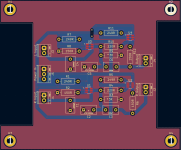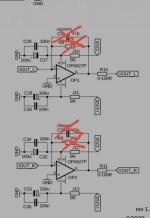I have both versions of V3.
Do they sound different? I don't really understand what the difference is: JLsounds state for both version "Galvanic isolation (outputs, two oscillators and reclock, done by Xilinx CPLD are after the isolator)", plus for the fully isolated version "if external power supply is applied, all outputs are isolated from USB ground". The older version without fully isolated outputs has some output pins that are not isolated, but the main signals (DATA, BCK, LR, MCK, MCK/2 etc.) are all isolated, right? Also I measure no GND connection between GND in the USB wire and GND at the output of my JLsounds v3 board...
Last edited:
I still don't know which one is better and why. There is no GND connection between GND in the USB part and GND at the output.
I'm currently using the old V3 and the new fully isolated one is back to the box, waiting for a new DAC with PCM63P-Y. Since now there is only this new one to buy, that's it. No turning back. 🤣
I'm currently using the old V3 and the new fully isolated one is back to the box, waiting for a new DAC with PCM63P-Y. Since now there is only this new one to buy, that's it. No turning back. 🤣
I agree with that opinion, I'm just looking for a reason why it's like that 🤣What are double blind tests worth when we are not blind but deaf.
And now, no kidding, everyone claims it sounds better. I haven't personally checked, but I know some that have. Two identical DACs, one with and the other without shift registers. So I'm just assembling one more PCM1702P-K, skipping the shift registers and connecting directly to the JLS.
Some people swapped another USB-I2S on shift registers for the jlsounds I2S directly bypassing shift registers, where tie improvement can be expected (due to a better LRCK in AD1862/5 or BCK in PCM1702/PCM63). But if the jlsounds was on the shift registers and then it was switched to direct drive and sound improvement was observed - this is what I still not get (and besides theory, I did not observe this in my real test experience 🤔)
An improvement in sound can be observed because the logic for the TDA1541 is touching LRCK and works differently from the AD1862 🙂On the same note, would you please share your thoughts on the sound quality of the DAC when FPGA is used instead of logic gates for TDA1541?
I've got one dead arcam alpha 5 plus with TDA1541A inside, the lens is not working instead of pulling out TDA1541 I was considering of converting it to a CD Player/DAC with output from CD filter going to FPGA and one I2S over USB with a push button the FPGA switches between USB and CD filter.
Miro, I follow simple logic. If only USB and JLS are used, a direct connection to the DAC chips is logical. If you want another card with I2S output, or more digital inputs, then I2S goes through the shift registers. The influence of the I/V stage and power supply is much greater than that. There is a real game.
Since I don't know much, I follow the line of least resistance and accept things as they are, I don't bother with explanations too much. And I use other people's experiences. This all sounds great anyway.
And I use other people's experiences. This all sounds great anyway.
If you haven't tried Amanero yet, give it a try, it's great value for money. 👍
Since I don't know much, I follow the line of least resistance and accept things as they are, I don't bother with explanations too much.
 And I use other people's experiences. This all sounds great anyway.
And I use other people's experiences. This all sounds great anyway.If you haven't tried Amanero yet, give it a try, it's great value for money. 👍
Is it possible to use the AD8066 in the I/V cascade of the AD1865 at +5-5V power supply? What kind of chain?
Thanks. I have observed a lot of unexpected behaviors from these DAC chips like TDA1541 doesn't like the USB signal from an IPAD USB port, AD1862 doesn't like the signal which is 24bit and higher than 96 KHZ, in both cases the USB interface remains Amanero with upgraded crystals and to get a better output from AD1865 DAC one needs to set the gain resistor to above 1.5k, these are just to name a few.An improvement in sound can be observed because the logic for the TDA1541 is touching LRCK and works differently from the AD1862 🙂
The AD1865˛&PCM63 works both at pure 24bit 384kHz, and the AD1862 works only at 24bit 192kHz, at 384k it has an undertone. Both with the same PS and same JLS card via shift registers. I don't think it matters, I'm just saying. 😎
It works 32bit here on MacOS - DSD is written on the display 🤣
Obviously. Plays best at 96khz 32bit...It kills it 😉It is PRC display. 🤣
Planning on building the opa861 based i/v for my ad1862 proposed by crymen. Do I just hook the L and R outputs of the ad1862 board to the inputs of the I/V board then the outputs of the I/V board to the RCA terminals? Then just leave the dip8 unpopulated on the ad1862 dac board? Do I need to remove any resistors or capacitors around the Dip8 socket?
Thanks
Thanks
Attachments
Guys, where I can buy a pair of the PCM1702P? I was heard something about of the degradation used chips, is it true?
It can degrade (most likely does) from desoldering yes. Check ebay, last i saw polida had them in stock, and nixie purchased already from him.
- Home
- Source & Line
- Digital Line Level
- DAC AD1862: Almost THT, I2S input, NOS, R-2R

